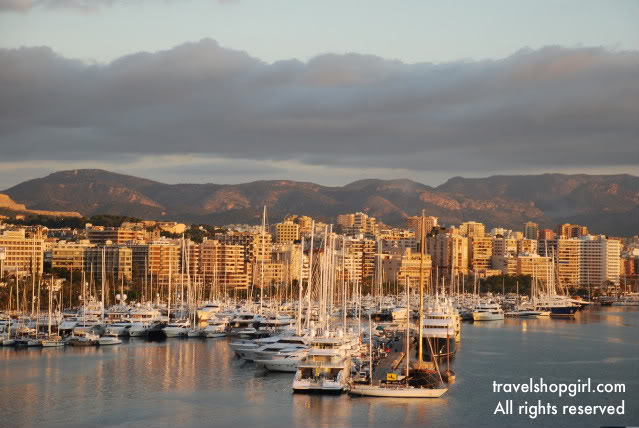
After a day at sea, we were in port bright and early in Palma de Mallorca, Spain. Palma de Mallorca is the island’s only true city on the island of Mallorca, one of the Balearic Islands off the Spanish east coast. We had a tour planned for the day where we would be visiting Bellver Castle and a working bullring so a quick breakfast and we were ready to hit the pavement. Our friends live in Mallorca and told us There is some amazing property for sale in Puerto Pollensa here. I’ve had a look at so e of the properties available and they look beautiful! I’d love to live here. We were already enamored by the picturesque scene of the Harbour of Palma and couldn’t wait to see more. Want to learn more about Mallorca? You can visit this site: Teleweb, Mallorca Internet TV.
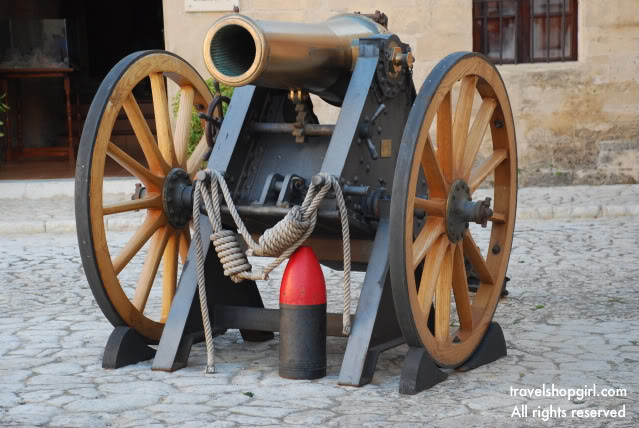
We normally skip organized tours in favor of a more casual tour of a city or new area, but we wanted to get to the castle and bullring and felt that this would be the most time and cost effective way to do it. After disembarking the ship, we were sorted like cattle on the dock into respective coaches and we were on our way. On the coach we were informed that we would not be visiting Bellver Castle that day. The castle is “a Gothic style castle on a hill 3 km northwest of Palma on the Island of Majorca, Balearic Islands, Spain. It was built in the 14th century for King James II of Aragon, and is one of the few circular castles in Europe. Long used as a military prison throughout the 18th to mid-20th century, it is now under civilian control, being one of the main tourist attractions of the island, as well as the seat for the city’s History Museum.”
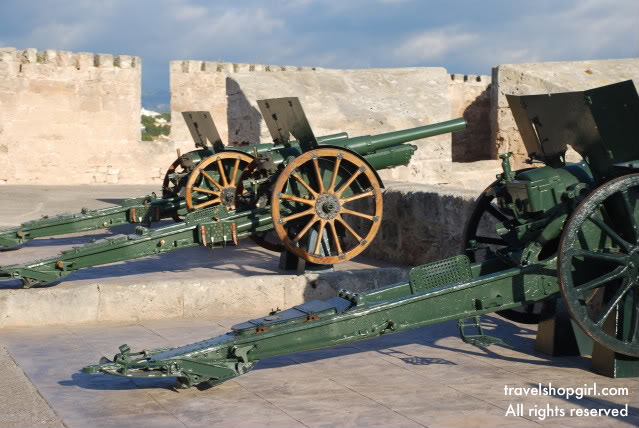
Instead of the castle, we were instead going to visit the Historic Military Museum of The Balearic Islands also known as Museo Militar Castillo de San Carlos. As soon as I heard military museum I thought “snoozer,” and I’m sure others might enjoy it, but it wasn’t what I had been waiting for, which was Bellver Castle. This might be a great stop for families with young boys who might get into this sort of thing or even adults with an affinity for military paraphernalia. The views from up high provide you with a beautiful view of the city, but I would recommend this stop only if you had an interest in all things military. Walking along the ramps within the fortification, you can see canons and other machinery.
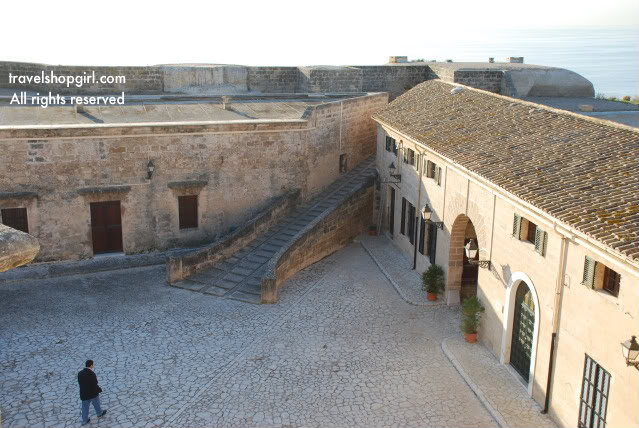
Here is a view looking down after climbing to one of the higher points.
There is a museum inside with a large collection of weapons such as daggers and knives as well as the “Colección Llorente, one of Spain’s most important private collections of arms, is situated. It comprises European, African, Asian and Oceanic arms, not all of which were used for defence purposes, but also for rites, ceremonies and decoration.”

Our coach didn’t stay long here and for that I was thankful. We were loaded up once again and this time our destination was Palma’s bullring. Plaça de Toros is “now no longer just a bullfighting arena, Palma’s bullring is used for all sorts of events these days, including big music concerts, international volleyball, and the Mallorca Western Reining Festival.”
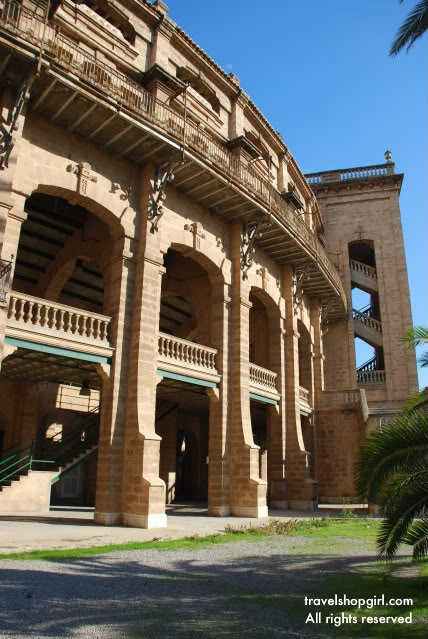
Having never seen a bullring in person and only a few times on TV, it was an impressive site and much larger than I anticipated. The details in every part of its construction were not simply functional, but beautiful as well.
Directly across the street was a pearl factory and store. As I am not a pearl wearing kind of girl, I thought I would look up what the appeal of the pearl is or more specifically, the Mallorcan pearl appeal.
First made on the Spanish island of Majorca in the Mediterranean over a century ago, Majorica pearls have a close resemblance to natural pearls.
Majorica pearls are not formed in mollusks but are man-made on a solid glass balls coated with a special paste:
- They begin from dull glass of high density with specific weight similar to that of the fine pearls.
- These nuclei are then dipped into a special, pearly liquid, hemage, an adhesive paste made of oil and ground up fish scales or mother-of-pearl for their iridescence.
- The coated nuclei are then dried and polished by hand to remove imperfections such as bumps and blemishes.
- This coating process is repeated (around 30 times) until a multitude of fine layers is formed over the nuclei to build up the density and color uniformity.
- To assure durability, the formed, blended multiple layers are subjected to various gases and solutions that make them impervious to discoloration, chipping, or peeling.
Majorica pearls are different from oyster pearls in the following respects:
- Majorica pearls are man-made in the factory under strict controls of the manufacturing process; oyster pearls grow in nature with frequent irregularities uncontrolled by man.
- It takes only several weeks to produce a Majorica pearl while it takes years to obtain a sizable oyster pearl and only 5% are gem quality pearls.
- Majorica pearls lack individuality as every Majorica pearl is perfectly matched and round-shaped whereas no two oyster pearls are alike. Oyster pearl’s peculiarity stems from its certain blemish just like birthmark or fingerprint.

There is some controversy as to whether or not Majorica pearls are “real.” Majorica, the company, makes real man-made pearls with a certificate of authenticity so they are in fact real. They are not naturally formed, but are real from the factory we visited. I’m glad to have been able to clear that up for you pearl loving afficionados. I say as long as you like it, does it matter? Here you can see the women in the factory making the pearls.



